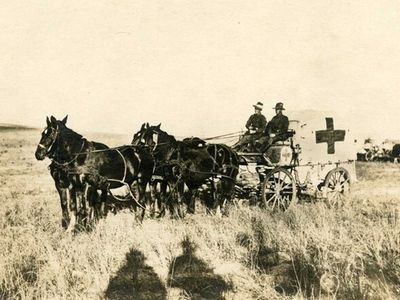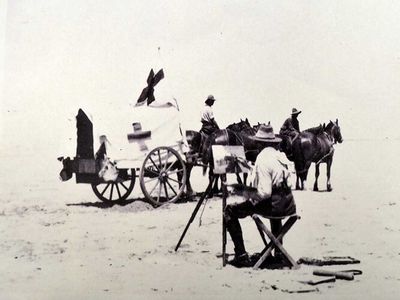“Major Avery, among many other Old Boys, holds a special place on the TGS Old Boys’ Wall of Achievement for his role in inventing the “Rapid Transit Ambulance” that was a key part of the Australian Light Horse Brigade.”

On ANZAC Day, we come together to reflect on the importance of service and sacrifice.
Toowoomba Grammar School would like to acknowledge our admiration for the loyalty, service and bravery exhibited by TGS Old Boys who so valiantly served. We are all the beneficiaries of their sacrifice, and their selfless actions continue to inspire a spirit of service amongst our current students.
Today we focus on the contribution of one TGS Old Boy who made a significant contribution to World War I. Here is some of the incredible story of Major Avery, DSO and if you visit the School Museum and Archives you can see a display in his honour.
Much of this history has been captured through countless hours of dedication and devotion by current TGS museum volunteer and former TGS staff member, Mrs Ann Hallam who managed the School’s Cadet Unit from 2006-2019.
Major Avery DSO, inventor of the WWI “Rapid Transit Galloping Ambulance”
Distinguished TGS Old Boy, Leonard Grimes (1880-1885) was born in Queensland in 1869 and died in 1953. Grimes attended the School in the days of Sir Harry Chauvel and Sir Littleton Groom and while at TGS was known as Leonard Avery Grimes.
After his School days he went on to Wadham College, Oxford, where he graduated with a medicine degree. He later changed his name to Conrad Avery and after some years as a hospital physician and surgeon, Avery enlisted with the British Army and joined the Suffolk Imperial Yeomanry. He was later promoted to Major and joined the Royal Army Medical Corps. During World War I he was enlisted with the Royal Westminster Dragoons and served in Palestine, Egypt and Syria.
Major Avery, among many other Old Boys, holds a special place on the TGS Old Boys’ Wall of Achievement for his role in inventing the “Rapid Transit Ambulance” that was a key part of the Australian Light Horse Brigade.
Light Horse Field Ambulance
The Light Horse units were mounted infantry with efficient mobile medical support to the wounded and sick soldiers of an Australian Light Horse Brigade. The Field Ambulance ensured the removal of the wounded from the front line to the advanced dressing station where there were surgical and resting tents.
These sand carts had two wheels with tyres that were wide enough to stop the cart digging into soft sand and could carry two or three stretchers. In heavy sand four horses were necessary to pull the cart, and the cart had to be steered by a rider on one of the lead horses.

Australian Light Horseman
The 2nd Light Horse Field Ambulance was formed in Brisbane with much of the unit coming from Queensland.
More than 15 TGS Old Boys enlisted with the Second Light Horse Brigade, two of whom died at Gallipoli: Major Dugald Maxwell Lockwood Graham and Trooper Gordon Holmes Robertson.
During the World War I, George W. Lambert (1873-1930) served Australia as an Official War Artist attached to the ANZAC Mounted Division. He spent two terms in service, the first with the Light Horse in Palestine, and the second in Gallipoli and Egypt before his military contract discharge.
As a result of Lambert’s service during World War I, he was offered a variety of commissions to paint scenes from significant war time events, including an activity of the 2nd Australian Light Horse Field Ambulance, Walk (An Incident at Romani).
The Battle of Romani was the last ground attack on the Suez Canal at the beginning of the Sinai and Palestine Campaign. The battle was fought from 3 to 5 August 1916 near the Egyptian town of Romani.
The completed painting was to be given to the Queensland (National) Art Gallery by the Light Horse in memory of their fallen comrades.
The Rapid Transit Ambulance
Major Avery describes his vision for a new galloping ambulance, known as “The Rapid Transit Ambulance”.
This ambulance was designed with a view to filling the want of stretcher bearers with mounted troops. The endeavor has been to construct a light strong carriage easily adjustable to any mounted horse and capable of keeping up with cavalry through any sort of country. As will be seen from the accompanying illustration, the ambulance is a two-wheeled contrivance.
The body consists of a platform fixed to a crank axle by long springs between 46-in. wheels. This platform is 2 ft. 3 in. from the ground and is arranged to carry an ordinary service stretcher. The forepart consists of a pair of short shafts which are attached to the body by an arrangement of springs adapted to prevent the side-to-side motion caused by the action of the horse. The shafts reach as far forward as the saddle flaps, where they are held in position by a girth strap, breastplate, and belly-band.
The body is covered by a canvas hood. The weight is about 3 cwt. Length overall, 12 ft. Track, 4ft. 1 in. Surgical dressings, splints, water-bottle, &c., are carried. It is quite easy for the driver, having placed a wounded or helpless man in a stretcher, to transfer him from the ground to the platform of the carriage single-handed.
This ambulance has been on duty with the Suffolk, Sussex, Surrey and Middlesex Imperial Yeomanry during their respective training, and with the Wiltshire Yeomanry through the recent maneuvers. It is a very comfortable conveyance and has proved capable of negotiating with almost any country.
Walk (An Incident at Romani)
The incident to which Lambert’s painting refers occurred during the Battle of Romani on 4 August 1916. The 2nd Light Horse Field Ambulance had deployed two sand-carts to an exposed part of the line to retrieve some seriously wounded men. Upon its return journey the Field Ambulance envoy came under Turkish fire and its panicked horses started to bolt.
Tragedy was averted when the corporal signaled ‘Walk’ and galloped to the front of the party to steady the teams. After the horses had been calmed and resumed their pace, the enemy apparently recognised the Ambulance’s mission and averted their fire. As a result of their bravery and composure during the incident the corporal and drivers were awarded Military Medals.

To enable Lambert to make sketches of the event that was already three years in the past, it was re-enacted at Kantara, Egypt in 1919. Photographs were taken of Lambert at work sketching this re-enactment. The completed painting portrays the moment when the corporal signals ‘Walk’ whilst rushing to the front of the group to steady the bolting teams.
Remembrance Day
Remembrance Day marks the anniversary of the Armistice which ended the First World War, signed at 11:00am on 11 November 1918. We still remember those who have given their lives in conflict before and since, by taking a minute to stop, be silent and remember the war that was to end all wars.
Latest Blog
The Power of Character and Connection Every Day
As we mark R U OK? Day, it’s a timely reminder of the importance of looking out for one another and staying connected. Whilst today is a National Day of Action, the message is clear: asking “R U OK?” should not be reserved for just one day of the year. By having regular, meaningful conversations with each other, we create trust and normalise talking about what’s really going on in our lives. This simple but powerful practice ensures that when someone is struggling, they know they have a…
Managing Conflict with Pre-Teens and Teenagers
Understanding the developmental challenges of our boys, particularly in managing emotional resilience and independence, helps parents navigate these moments more effectively. Conflict is a natural and inevitable part of adolescence, and for parents of preteens and teenagers at Toowoomba Grammar School, managing these moments effectively is key to nurturing their emotional growth and maintaining a healthy relationship.
Elevating Early Years Mathematics: Insights from a Global Teaching Fellowship
As a primary school teacher with ten years of classroom experience, I’ve had the opportunity to teach across year levels from Prep to Year 3. Throughout my teaching journey, I’ve developed a strong passion for ensuring that every student feels a sense of success in the classroom and equally, that every teacher feels confident and equipped to deliver high-quality lessons. Over time, I’ve become increasingly interested in how we can bring greater consistency and clarity to the way we teach…
Innovation at TGS: Preparing Boys for a Future of Possibilities
This commitment is reflected in how, for generations, our Old Boys have maintained strong connections with the School and their region, demonstrating a dedication to making a meaningful difference in the world. Having students who are able to think critically and evolve with technology will prepare them better for the workforce. Honouring the Past, Preparing for the Future The Grammar 150 celebrations this year offer a special opportunity to reflect on the significant contributions of our…
Remembering CMDR Rowley Alan Waddell-Wood
Rowley was born in Moree, NSW on 30 July 1932 and moved to a property on the Darling Downs at an early age. He attended Esk State School followed by two years at Toowoomba Grammar School (1946-47). After completing his schooling, he worked on the family property and then as a Trainee Executive at Coles in Brisbane. Always fascinated by flying and the Fleet Air Arm, Rowley signed up for a short service engagement in March 1954, aged 22. After completing basic training at HMAS Cerberus, he was…
75 Years of Rivalry and Respect
This year’s match holds special meaning, as it marks 75 years since the very first O’Callaghan Cup clash in 1950. Among those who remember the early days is Malcolm Powell, a proud TGS Old Boy (1948-52) who played fullback for the First XV in 1951. Malcolm, now in his nineties, still vividly recalls the thrill of those early games. “I watched the first Cup from the sidelines, I was in the Thirds that year,” Malcolm recalls. The fiercest of rivals but the greatest of friends “Downlands won that…
Our Sesquicentenary
The day was filled with reflection, celebration and a deep sense of connection to the generations who have shaped the School’s legacy. From the opening of a time capsule sealed in 1975, to a Sesquicentenary Assembly that honoured our roots and looked to the future, the occasion was a powerful reminder of what it means to be part of the TGS community. And of course there was cake! A Message Across Time: Opening the 1975 Time Capsule
Better Together - 2025 IBSC Conference
With its global network of over 300 member schools spanning more than 20 countries, the IBSC advocates for educational opportunities that focus on the holistic development of young men. This year, the IBSC Annual Conference was hosted by Belmont Hill School in Boston, United States, where teachers, school leaders and experts in boys' education gathered under the inspiring theme of "Better Together". Toowoomba Grammar School was proudly represented by Mr Luke Rawle, Ms Abby Varley and Mr Henry…
Reliving the Past, Shaping the Future
Mr Nicholas Hess has been a coach for both rugby and tennis and a boarding supervisor after he finished Year 12 His connection to the School runs deep, from the friendships he formed as a student to his dedication now as a Boarding House Assistant and long-standing member of the Old Boys’ Association (OBA). TGS has had a lasting impact on his life, and he has been only too willing to give back to the place that he loves so much. “There’s something special about being part of the Blue and Gold,”…